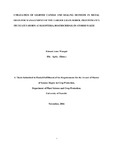| dc.description.abstract | Postharvest losses in maize in sub-Saharan Africa are estimated at 20% annually. Effective storage technologies will ensure food and income security for small holder farmers in developing countries. Larger grain borer (Prostephanus truncatus) is the most destructive pest of farm-stored maize causing losses as high as 30% in 6 months. Chemical pesticides are also available for the management of P. truncatus but have potential negative effects to human health and the environment. Globally, metal silos have been promoted for safe storage of grains at small holder levels. The metal silos are cheap, safe and environmentally friendly. To determine the effect of sealing metal silos with different materials available locally for the control P. truncatus in stored maize, an on-station trial with four treatments was conducted. Metal silos with a holding capacity of 100 kg were loaded with 90 kg of grain and a lighted candle placed on top of the grain. One hundred 10-day old P. truncatus were artificially introduced into the grain and the silo lids sealed with rubber band, grease, rubber band combined with grease and without rubber band or grease (control). The treatments were replicated four times, arranged in a completely randomized design and stored in a room roofed with corrugated iron sheets at ambient temperatures of 27±2oC and relative humidity of 58±5%.
A second on-station trial with five treatments was conducted. The experiment consisted of: metal silo loaded with 90 kg of grain and a lighted candle placed on top of the grain before sealing the metal silo with rubber band; metal silo loaded with 45 kg of grain and a lighted candle placed on top of the grain before sealing with rubber band; metal silo loaded with 90 kg of grain and sealed with rubber band without lighting the candle; metal silo loaded with
45kg of grain and sealed with rubber band without lighted candle and polypropylene woven bag loaded with 90 kg of grain and tied tightly with rubber band and sisal rope (control) .
After thirty five days of storage results from the first trial exhibited significant (p<0.05) differences in weight loss, grain damage and insect mortality. The metal silos sealed using rubber band combined with grease had significantly (p<0.05 the least weight loss (0.6%) and grain damage (4.5%) compared to the control which had the highest weight loss (1.9 %) and grain damage (6.6%). Metal silo sealed with rubber band combined with grease had significantly higher CO2 level (2.1% v/v) compared to the control which had the least amount of CO2 (0.5% v/v). Insect mortality (100%) was highest in metal silos sealed with rubber band, grease and rubber band combined with grease compared to the control which had the least (80%). A mean of 3 (F1) insect progeny emerged in the control after incubation and none in the other treatments.
From the second trial significant differences (p<0.05) were observed where the metal silo loaded with 45 kg of grain and a lighted candle had higher insect mortality (100%), higher CO2 level (3.3% v/v), lower O2 (17.6% v/v), lower grain damage (3.7%) and weight loss (0.7%) compared to the control that suffered the highest weight loss (22.2%), grain damage (49.4%), higher O2 level (20.94% v/v) and least CO2 level (0.05% v/v). The number of live LGB increased tenfold after ninety days of storage. Sitophilus zeamais and Tribolium castaneum infested the grain in the control. Grain germination rate in the control reduced significantly (p<0.05) from 66% to 49% compared to the metal silos where the rate reduced minimally from 66% to 62%.
Therefore, proper sealing of metal silo with either rubber band or grease and use of lighted candle effectively controlled P. truncatus and preserved grain in storage.
Use of lighted candles in metal silos interfered with air composition, quickly killing the LGB, resulting in reduced grain damage and weight loss of the stored maize. | en_US |



